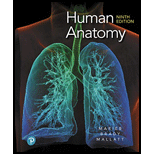
Where in the alimentary canal does propulsion occur?
To review:
The propulsion site in the alimentary canal.
Introduction:
Alimentary canal is a part of the digestive system of the human body. It is a passage starting from the mouth and ends at the anus. It is also known as the gastrointestinal tract. The mouth, pharynx, esophagus, stomach, small intestine, and large intestine which lead to the anus are organs of the alimentary canal.
Explanation of Solution
The process through which the movement of food along the alimentary canal occurs is known as propulsion. The propulsion occurs throughout the alimentary canal. It is initiated by a voluntary movement and gets continued by an involuntary movement. The involuntary movement initiating propulsion is the swallowing of food and the movement continuing propulsion is peristalsis.
Peristalsis is the process in which smooth muscles lining the walls of the organs of the alimentary canal contract and relax in an alternative manner. This enables the movement of food from one part of the alimentary canal to another. The mixing of food with digestive enzymes also takes place due to propulsion.
Want to see more full solutions like this?
Chapter 23 Solutions
EBK HUMAN ANATOMY
- There are a wide range of therapeutic applications available as options for patients. Medical professionals should be aware of these applications so they can make informed recommendations to patients. To gain a better understanding of some therapeutic applications and how they are related to RNA and mRNA, research long non-coding RNA. Respond to the following in a minimum of 175 words: What is lncRNA and what does it do? How does IncRNA differ from mRNA? What are some therapeutic applications associated with lncRNA? Think about possible future uses of this application. What are the advantages and disadvantages of this application and its continued use?arrow_forwardfour fish or mussel species that are native to the great lakesarrow_forwardThere are a wide range of therapeutic applications available as options for patients. Medical professionals should be aware of these applications so they can make informed recommendations to patients. To gain a better understanding of some therapeutic applications and how they are related to RNA and mRNA, research long non-coding RNA. Respond to the following in a minimum of 175 words: What is lncRNA and what does it do? How does IncRNA differ from mRNA? What are some therapeutic applications associated with lncRNA? Think about possible future uses of this application. What are the advantages and disadvantages of this application and its continued use?arrow_forward
- four physial characteristics of a fish or a mussel that would help you identify it to a speciesarrow_forwarddescribe what you would do in this situation, you are working ona. river and it will take 20 minutes by boat to get back to the field truck, you are 1 hour from finishing the field work on the last day of field trip. you hear thunder int he dsitnace, what did you do?arrow_forwardunu grow because auxin is still produced in the tip to Another of Boysen and Jensen's experiments included the use of mica, explain why one of the shoots was able to show phototropism and the other was not. Mica Wafer Ligh c. They then t but this time permeable n shoot. Why phototropis Light Mica Wafer Coleoptile tips Tips removed: agar Explain why the shoo direction after the ag the cut shoot, even tarrow_forward
- Discussion entries must be at least 250 words to fulfill the assignment requirements. You must complete your entry before you will be able to see the responses of other students. Responses to other students are encouraged but not required. Grading for discussion entries will be based on application of course concepts, proper grammar, and correct punctuation. Read one the attached article and explore the Human Development Index (https://hdr.undp.org/data-center/human-development-index#/indicies/HDI). In your opinion, is the Human Development Index a good measure of the well- being of the people of a nation? Are the items measured in the HDI valid and relevant in the modern global economy? How are they related to the political economy of a nation? The attached articles propose some alternative measures of well-being. In your opinion, are there other measures of well-being that might be better alternatives to the items in the current HDI?arrow_forwardA patient visits her doctor with symptoms typical of a bladder infection. She is immediately prescribed an 800 mgdose of antibiotic (bioavailability = 1/2, t½ = 12 h). The corresponding plasma concentration of drug is found to be 96 micrograms/ml. What is the volume of distribution of this drug? Please round to the nearest liter.arrow_forwardA 10 mg/Kg dose of a drug is given by intravenous injection to a 20 Kg dog. What would the volume of distribution be if the drug had been given orally and only 50% of the drug was absorbed (the concentration of drug at time = 0 is 0.1 mg/L)? Be sure to show your work.arrow_forward
- After oral administration of 10mg of a drug, 50% is absorbed and 40% of the amount absorbed is metabolized by the first pass effect. The bioavailable dose of this drug is ______. Make sure to provide units for your answer. Show your work.arrow_forwardA 10 mg/Kg dose of a drug is given by intravenous injection to a 20 Kg dog. What is the volume of distribution of the drug in liters if the plasma concentration is 0.1 mg/L (assume the drug is instantaneously distributed)? Be sure to show your work.arrow_forwardUsing a BLAST search, what class of proteins is similar to bovine angiogeninarrow_forward
 Human Physiology: From Cells to Systems (MindTap ...BiologyISBN:9781285866932Author:Lauralee SherwoodPublisher:Cengage Learning
Human Physiology: From Cells to Systems (MindTap ...BiologyISBN:9781285866932Author:Lauralee SherwoodPublisher:Cengage Learning Concepts of BiologyBiologyISBN:9781938168116Author:Samantha Fowler, Rebecca Roush, James WisePublisher:OpenStax CollegeEssentials of Pharmacology for Health ProfessionsNursingISBN:9781305441620Author:WOODROWPublisher:Cengage
Concepts of BiologyBiologyISBN:9781938168116Author:Samantha Fowler, Rebecca Roush, James WisePublisher:OpenStax CollegeEssentials of Pharmacology for Health ProfessionsNursingISBN:9781305441620Author:WOODROWPublisher:Cengage Human Biology (MindTap Course List)BiologyISBN:9781305112100Author:Cecie Starr, Beverly McMillanPublisher:Cengage Learning
Human Biology (MindTap Course List)BiologyISBN:9781305112100Author:Cecie Starr, Beverly McMillanPublisher:Cengage Learning





